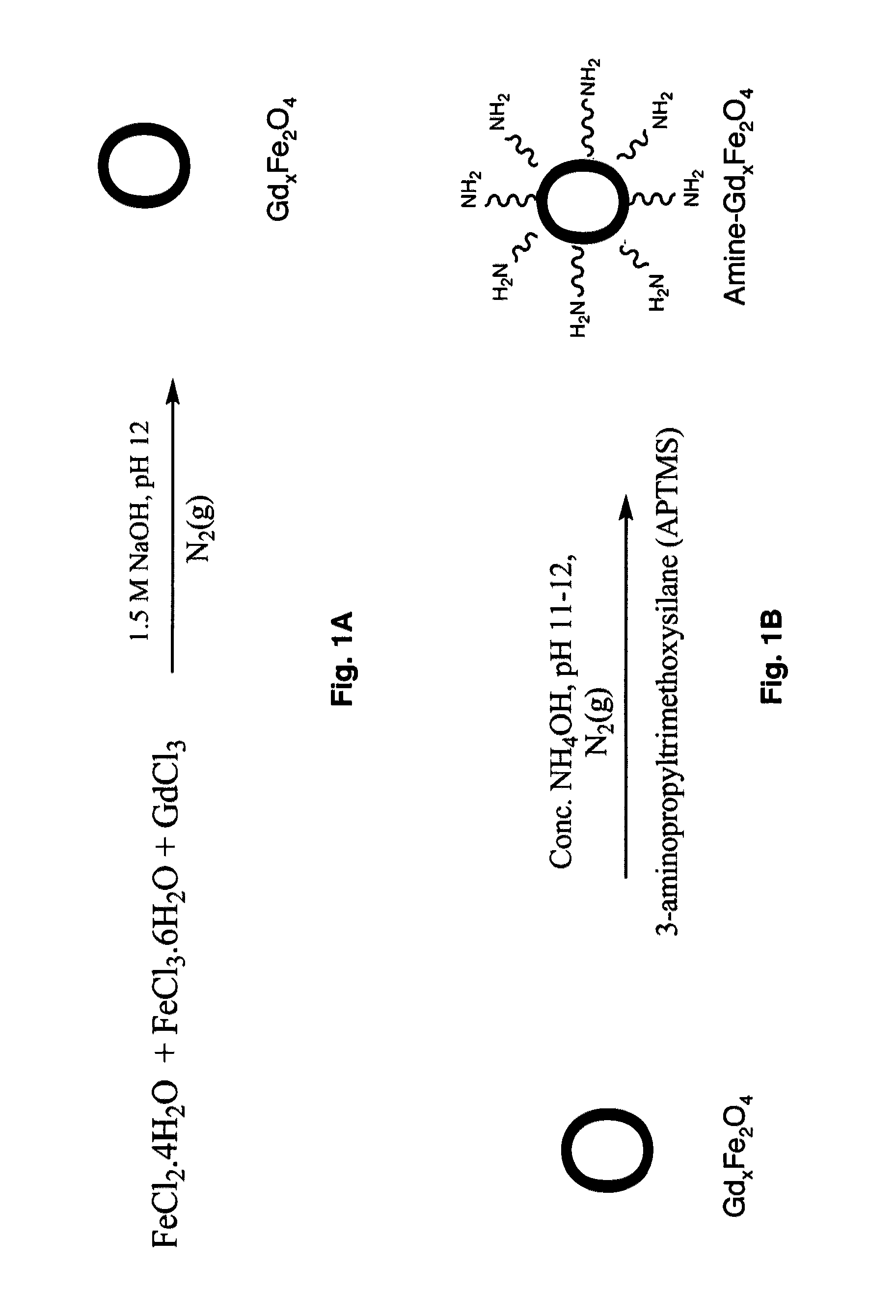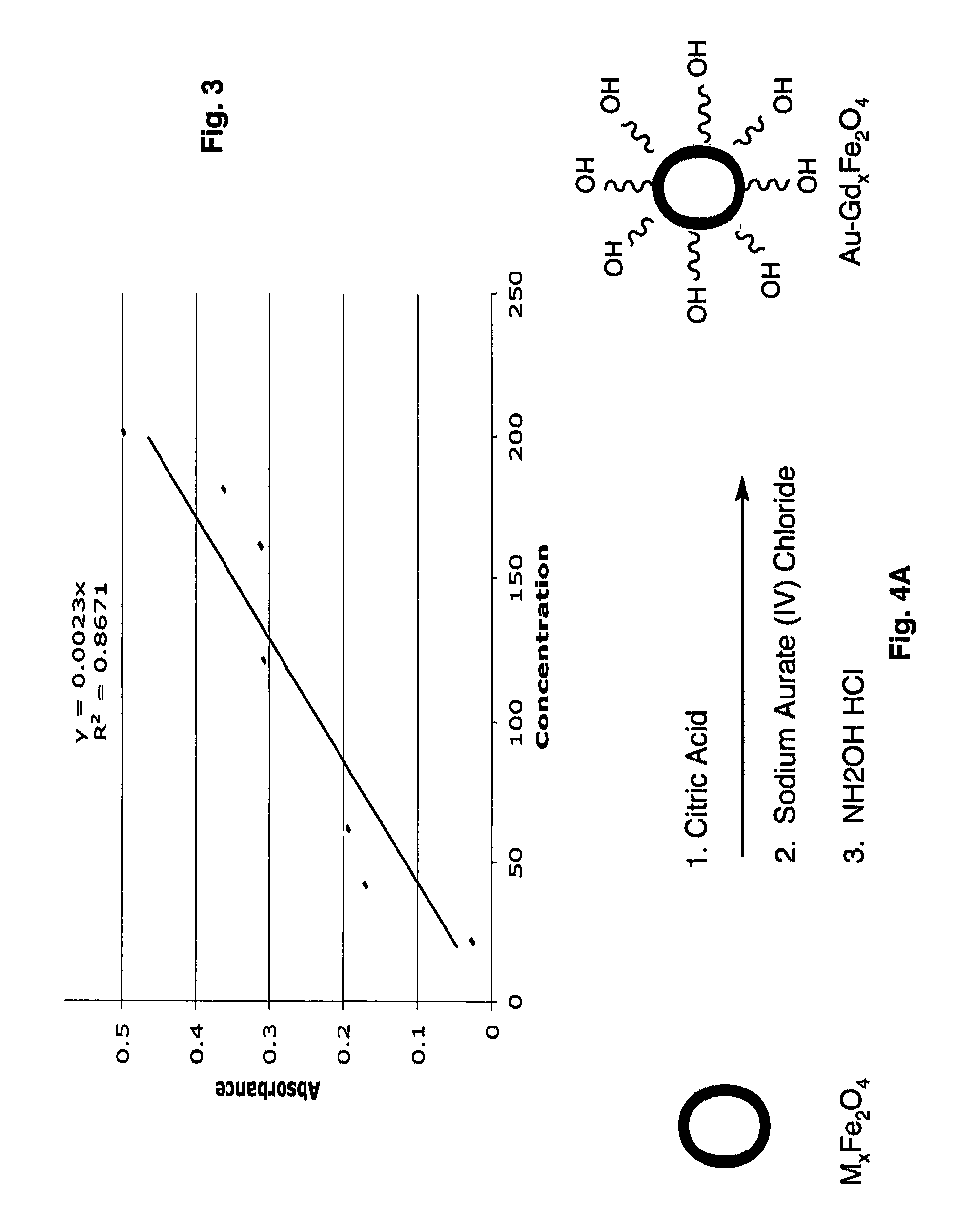Ultrasmall superparamagnetic iron oxide nanoparticles and uses thereof
a superparamagnetic iron oxide and nanoparticle technology, applied in the field of iron oxide nanoparticles, can solve the problems of poor clinical outcome, inability to conjugate biomolecules, and insufficient biomimetic contrast agents in the prior ar
- Summary
- Abstract
- Description
- Claims
- Application Information
AI Technical Summary
Benefits of technology
Problems solved by technology
Method used
Image
Examples
example 1
Synthesis of Metal- and Undoped Ultrasmall Paramagnetic Iron Oxide Nanoparticles (USPION)
[0080]The synthesis of undoped iron oxide nanoparticles and gadolinium, manganese, cobalt, and ruthenium doped iron oxide nanoparticles were carried out using a modified procedure by Hong et al. (17) For metal-doped particles, the concentration of the gadolinium ions in the final product was 0, 2, 4, 6, 8, and 10 % and was 8% for both manganese and cobalt to the total amount of the Fe3+ / Fe2+ ions. Calculations were done such that the concentration of Fe2+ / Fe3+=1. Calculated amount of FeCl2.4H2O (M.W: 198.81) and FeCl3.6H2O(M.W: 270.3) and, for metal-doped nanoparticles, a stoichiometric amount of metal chloride salts were weighed and dissolved in ultra-pure water. Table 1 shows the amounts of FeCl2.4H2O, FeCl3.6H2O and gadolinium used in the nanoparticle core.
[0081]
TABLE 1Amount ofAmount ofFeCl2•4H2OFeCl3•6H2O1.5 g Fe3O4 + 0 g Gd0.6348g0.8651g(0%)(3.2mmol)(3.2mmol)1.47 g Fe3O4 + 0.03 g Gd0.6221g...
example 2
Spectroscopic Characterization of GdUSPIO and Amine-GdUSPIO Nanoparticles Fourier Transform-Infra Red (IR) Vibrational Spectrum
[0088]To confirm the presence of the amine groups present on amine-GdUSPIO, FT-IR spectroscopy was used for both GdUSPIO and amine-GdUSPIO. The FT-IR spectra were measured at room temperature with a Nicolet Avator 360 FT-IR spectrophotometer (Varian, Palo Alto, Calif.). Sample concentrations in the pellets were ˜1 mg of sample / 200 mg of KBr salt. The synthesized MNPs were pressed into KBr pellets to record the solid state infrared spectra. To improve the signal-to-noise ratio, multiple scans (264) of each sample were collected and the slowly sloping baselines were subtracted from the digitally collected spectra using GRAMS / 32 software package (Thermo Galactic, Inc. Salem, N.H.).
[0089]The combined FT-IR spectra of synthesized amine-GdUSPIO (FIG. 5A—top) and GDUSPIO (FIG. 5A—bottom) showed the spinel structure of GdUSPIO and amine-GdUSPIO with vibrational band...
example 3
USPIO-PEG400-b-Peptide-mPEG2000
Synthesis of Homobifunctional COOH-PEG400-COOH Diacid
[0101]The homobifunctional PEG400 diacid is synthesized according to the following procedure. Briefly, 20 g of PEG400 is dissolved in 300 mL acetone with vigorous stirring in an ice bath. After 15 minutes, 40 mL of Jones reagent (chromium oxide, sulfuric acid, and water) is slowly added and the reaction is stirred for 16 hours. After this time, 20 mL of isopropanol is added to quench the reaction and 2 g of activated carbon is added and stirred for 2 hours. After this time, the reaction mixture is filtered and the solvent is evaporated. The product is obtained from solvent extraction with methylene chloride (CH2Cl2) and characterized with 1H NMR. FIG. 6A shows that PEG methylene (—CH2) protons, and end methylene (—O—CH2) protons of PEG400 are observed at about 1.35 ppm (a), 4.23 ppm (b) and 3.79 ppm (c) with no impurities observed from the spectrum as expected.
Synthesis of heterobifunctional HOOC-PE...
PUM
| Property | Measurement | Unit |
|---|---|---|
| particle size | aaaaa | aaaaa |
| near infrared wavelength | aaaaa | aaaaa |
| diameter | aaaaa | aaaaa |
Abstract
Description
Claims
Application Information
 Login to View More
Login to View More - R&D
- Intellectual Property
- Life Sciences
- Materials
- Tech Scout
- Unparalleled Data Quality
- Higher Quality Content
- 60% Fewer Hallucinations
Browse by: Latest US Patents, China's latest patents, Technical Efficacy Thesaurus, Application Domain, Technology Topic, Popular Technical Reports.
© 2025 PatSnap. All rights reserved.Legal|Privacy policy|Modern Slavery Act Transparency Statement|Sitemap|About US| Contact US: help@patsnap.com



